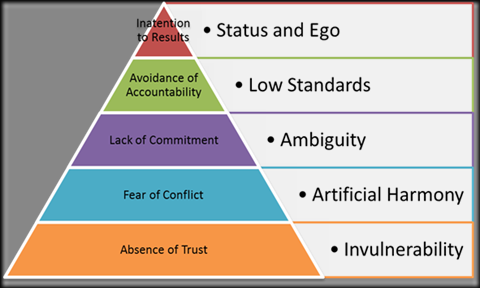Why is teamwork so hard? How to develop better team working
February 29, 2020
Having worked out what is and isn’t a team last month, this month I’m looking at why so many teams fail to work well together and what you can do to develop better team working.
The insecure leader
One of the first reasons teams fail is not recognising that they are – or should be – a team in the first place. This generally happens when a leader (in the loosest sense) manages relationships with their direct reports on a 1:1 basis. This may reflect personal preferences or a lack of understanding of how a team could function. But it’s often the hallmark of an insecure leader who doesn’t know how to harness the collective power of the group. They feel more in control if they keep everyone separate. Some leaders actively discourage dialogue and collaboration between staff for fear of what they might get up to without them.
The five dysfunctions
Even when a leader wants to create a good team, things get in the way. Patrick Lencioni, whose book The five dysfunctions of a team is one of my top recommended reads, has identified a pyramid of dysfunctional team characteristics:

Let’s pick those apart one by one.
1. Absence of trust
In a poorly functioning team, people don’t trust each other. They may not actively distrust each other, but they don’t feel comfortable enough to be vulnerable – to say something risky, admit a mistake or ask for help. In the absence of trust, people pretend they are invulnerable. In this context, good team work is almost impossible.
2. Fear of conflict
Notice that conflict itself is not a hallmark of a dysfunctional team, it’s fear of it that kills teamwork. People who don’t trust each other are unable to have robust debates about the things that matter. They shy away from difficult issues and maintain artificial harmony. As I’ve discussed here before, a well-functioning team is not necessarily harmonious. If you agree on everything, you either haven’t really thought through all the issues or you’re stuck in group think.
3. Lack of commitment
If conflict is avoided, issues don’t get properly aired. When team meetings are a predictably dull trudge through familiar agenda items, skirting around hot topics that might cause a flare up, nothing ever gets resolved. You end up with a vague, woolly consensus. Everyone can get behind it because they’re not really committing to anything tangible.
4. Avoidance of accountability
When there is no clear plan of action, team members have no way of holding each other to account. Someone may suspect that a colleague is not pulling his weight or that his work is not up to standard, but without an agreed plan, it’s not easy to say anything (except on the sly to someone at the coffee machine). Standards slip, mediocre performance is tolerated and the team leader is the only one holding anyone to account – and quite often, they don’t do it either.
5. Inattention to results
If the team hasn’t agreed what it was collectively trying to achieve and no one is accountable for their performance on behalf of the team, people will naturally focus on their own objectives. Their career development, their department’s needs, their need for recognition will trump the needs of the team, not least because those needs aren’t clear. They may even compete with each other, rather than working towards common goals.
Turning it around
So how do you get around this, if you’re a leader trying to get your team working effectively? You have to start at the bottom of the pyramid and work on each layer in turn.
1. Build trust
Work on relationships first. When I work with teams, I always start here. Encourage your team to get to know each other as people. Role model the right behaviours. Reveal your own vulnerabilities, admit to mistakes, and don’t react badly if other people make themselves vulnerable by acknowledging mistakes or weaknesses. Apologise if you get things wrong, particularly in your handling of others. Be trustworthy.
2. Normalise conflict
Let people know you expect disagreement. Don’t overreact when people disagree with you; it’s not a sign of disrespect. Don’t close down discussions if they get heated. Remind people that this is a good sign of a team working well. Discourage personal attacks but keep exploring different perspectives until you have clarity. Make sure the quiet ones get their say too.
3. Commit to joint decisions
This absolutely not the same as compromise or consensus. It’s about hearing all sides and then agreeing on the right route for the organisation. Inevitably, some people (including, sometimes, the leader) will not get their way. Familiarise your team with this vital concept:
Disagree and commit
An example from outside work illustrates this best. Imagine a couple who cannot agree on whether or not to have a baby. There is no compromise, no half a baby, no part-time baby. The couple has to work through this. They either separate because they want incompatible things or one of them gets to the point of saying “I can live with this decision”. And then they have to get behind it 100% because the alternative would be terrible – one of them grudgingly agrees to have a child and then says “well this wasn’t MY idea” every time they face a difficult parenting issue. Or the other one agrees not to have a child and spends the next 20 years broodily, resentfully fondling baby booties and sighing.
Whichever way the decision goes you have to make your peace with it. The same applies at work. Even if you didn’t get your preferred outcome, you have to commit to that decision and get behind it as much as if it had been your idea.
4. Encourage people to hold each other to account
Be clear at the end of each meeting what you have agreed to do, what you have ruled out doing and who’s doing what, by when. Have clear agreed standards of both quality of work and acceptable behaviour. When the team knows what they’re aiming for and what good performance looks like, people are much more likely to do their bit and to pick others up on it if they don’t do theirs. It shouldn’t all get left to you as the team leader and the team should be willing to hold you to account too.
5. Keep a focus on collective results
If people are rewarded or praised for what they contribute to the overall results, then it will be easier for them to put aside their personal agendas for the greater good. Keep team results as the main focus of your meetings.
You can probably see how difficult it would be to try to start by focusing on results, without the preceding steps. It’s like trying to put the roof on before the foundations are in place. I’m not suggesting that any of this is easy. It takes a level of emotional maturity that I believe is a lifelong quest, particularly for leaders. But it is possible. If you’d like some support along the way, do get in touch: caroline@carolinegourlay.co.uk
Photo credits





